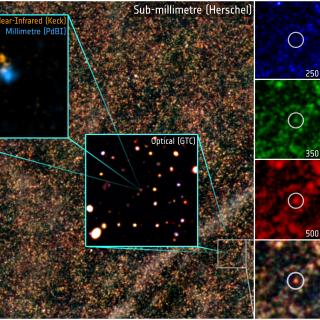Bibcode
Magdis, G. E.; Rigopoulou, D.; Hopwood, R.; Huang, J.-S.; Farrah, D.; Pearson, C.; Alonso-Herrero, Almudena; Bock, J. J.; Clements, D.; Cooray, A.; Griffin, M. J.; Oliver, S.; Perez Fournon, I.; Riechers, D.; Swinyard, B. M.; Scott, D.; Thatte, N.; Valtchanov, I.; Vaccari, M.
Bibliographical reference
The Astrophysical Journal, Volume 796, Issue 1, article id. 63, 18 pp. (2014).
Advertised on:
11
2014
Journal
Citations
71
Refereed citations
67
Description
We present Herschel far-IR photometry and spectroscopy as well as
ground-based CO observations of an intermediate redshift (0.21 <= z
<= 0.88) sample of Herschel-selected (ultra)-luminous infrared
galaxies (L IR > 1011.5 L ☉).
With these measurements, we trace the dust continuum, far-IR atomic line
emission, in particular [C II] 157.7 μm, as well as the molecular gas
of z ~ 0.3 luminous and ultraluminous infrared galaxies (LIRGs and
ULIRGs) and perform a detailed investigation of the interstellar medium
of the population. We find that the majority of Herschel-selected
intermediate redshift (U)LIRGs have L C II /L FIR
ratios that are a factor of about 10 higher than that of local ULIRGs
and comparable to that of local normal and high-z star-forming galaxies.
Using our sample to bridge local and high-z [C II] observations, we find
that the majority of galaxies at all redshifts and all luminosities
follow an L C II –L FIR relation with a
slope of unity, from which local ULIRGs and high- z
active-galactic-nucleus-dominated sources are clear outliers. We also
confirm that the strong anti-correlation between the L C II
/L FIR ratio and the far-IR color L 60/L
100 observed in the local universe holds over a broad range
of redshifts and luminosities, in the sense that warmer sources exhibit
lower L C II /L FIR at any epoch. Intermediate
redshift ULIRGs are also characterized by large molecular gas reservoirs
and by lower star formation efficiencies compared to that of local
ULIRGs. The high L C II /L FIR ratios, the
moderate star formation efficiencies (L IR/L\prime
_CO or L IR/M_H2), and the relatively low
dust temperatures of our sample (which are also common characteristics
of high-z star-forming galaxies with ULIRG-like luminosities) indicate
that the evolution of the physical properties of (U)LIRGs between the
present day and z > 1 is already significant by z ~ 0.3.
Related projects

Formation and Evolution of Galaxies: Observations in Infrared and other Wavelengths
This IAC research group carries out several extragalactic projects in different spectral ranges, using space as well as ground-based telescopes, to study the cosmological evolution of galaxies and the origin of nuclear activity in active galaxies. The group is a member of the international consortium which built the SPIRE instrument for the
Ismael
Pérez Fournon